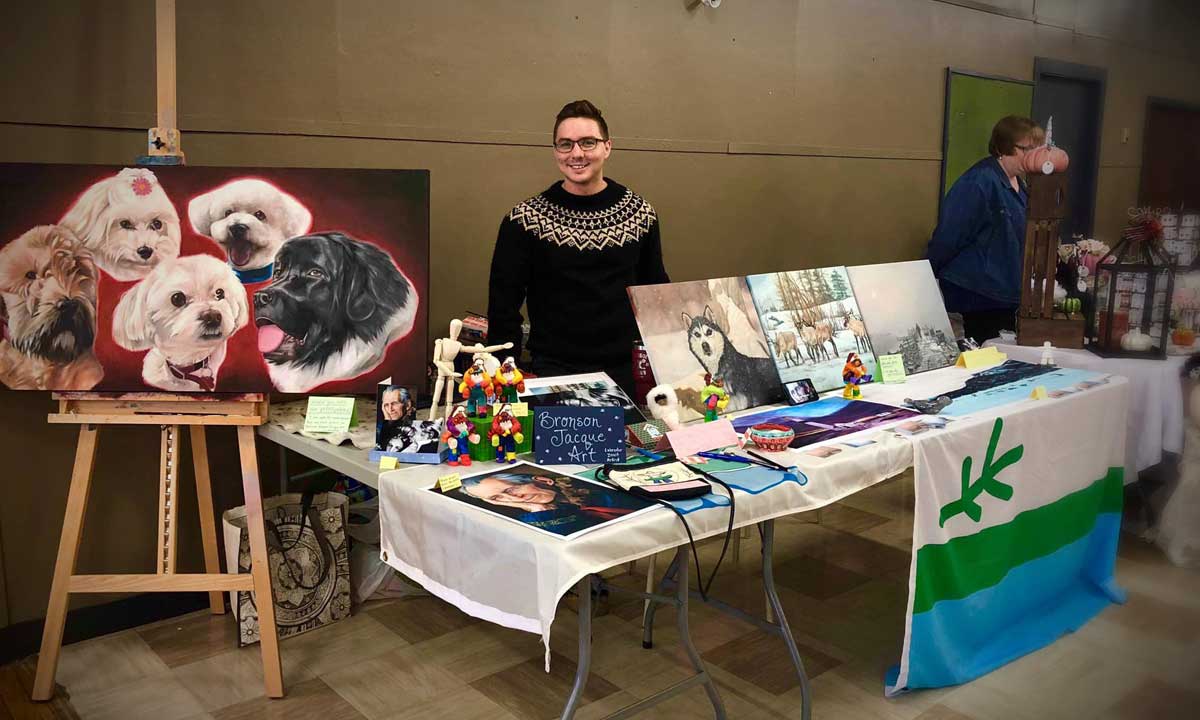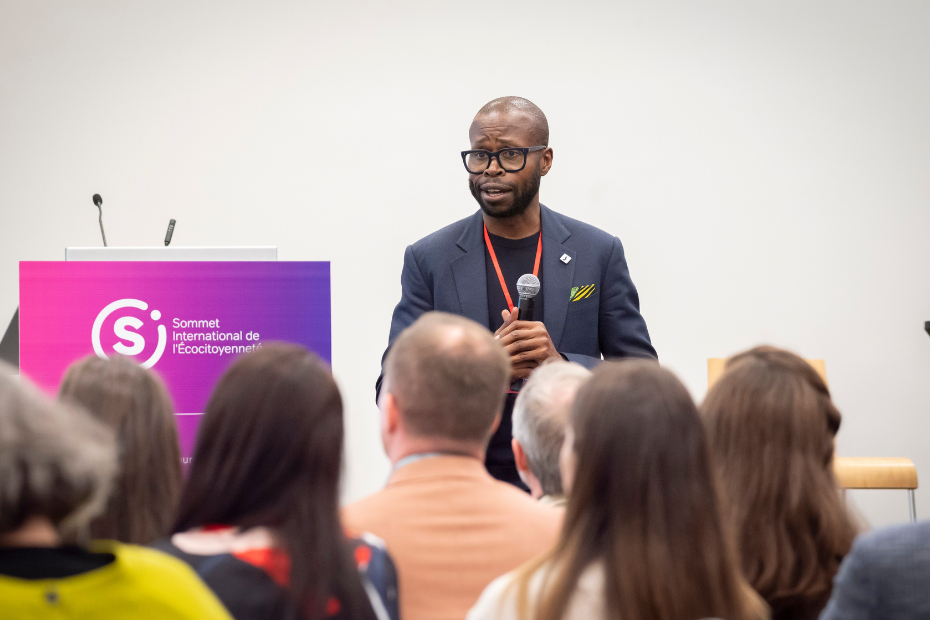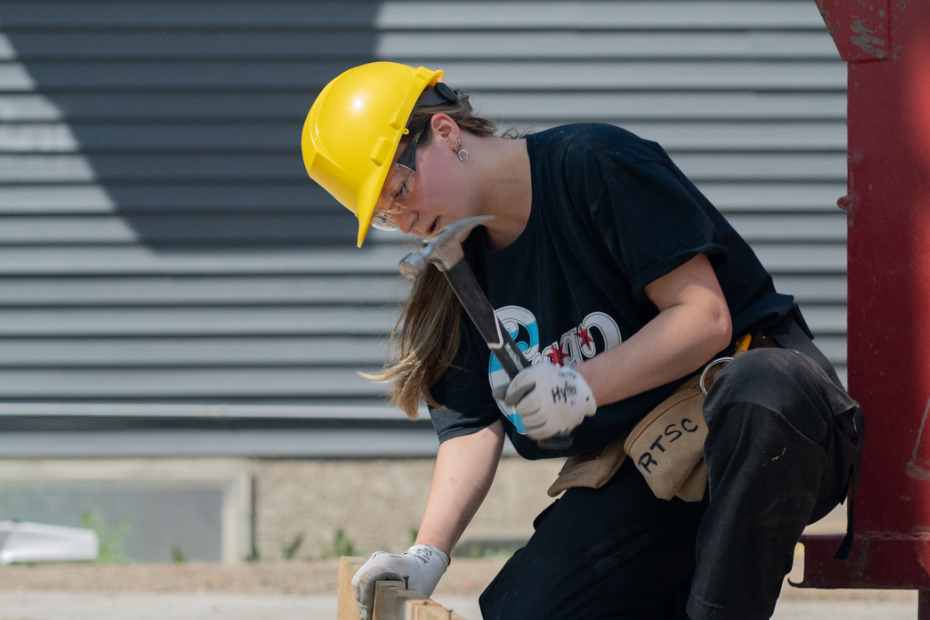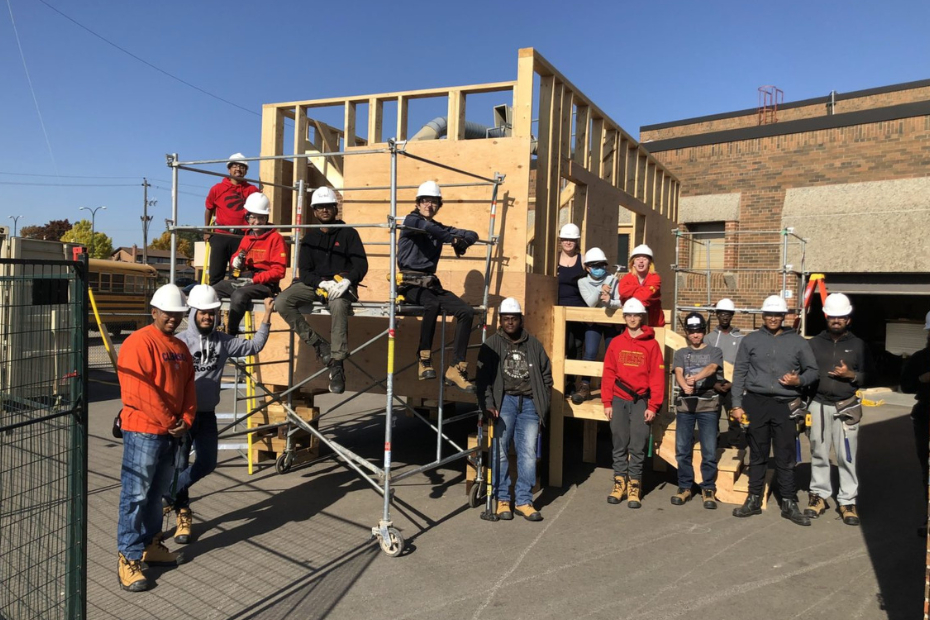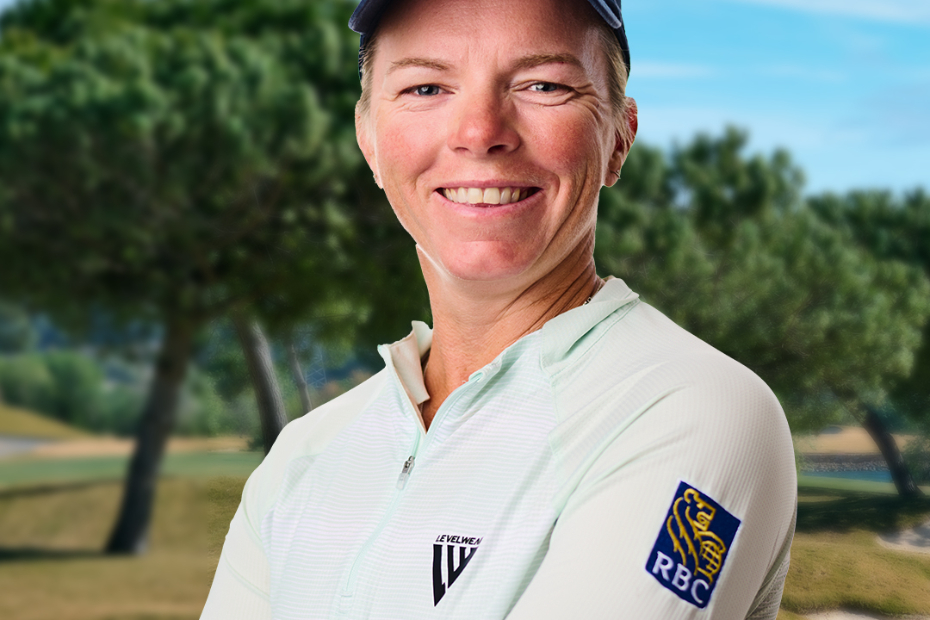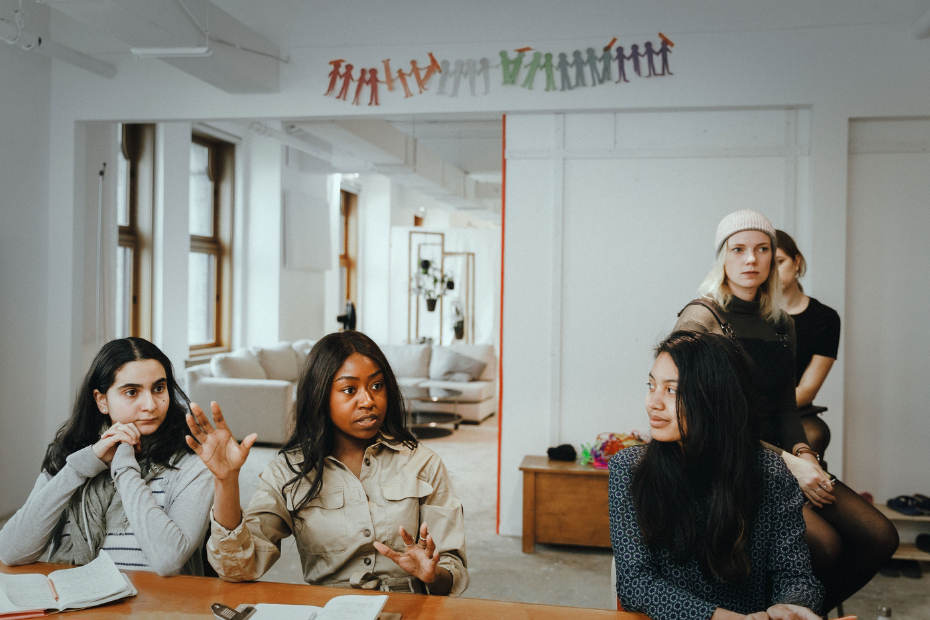Read this article in Inuktitut.
To see more of Jacque’s artwork, visit his artist site.
Bronson Jacque, a young Inuit painter from Postville, Nunatsiavut, NL, is about to experience a first in his career: having his work exhibited in an art museum dedicated to the art and culture of Inuit from Canada and beyond.
Qaumajuq (pronounced KOW-ma-yourq or HOW-ma-yourk) is the world’s first art museum dedicated to Inuit art and culture. Connected to the Winnipeg Art Gallery (WAG), Qaumajuq’s first exhibition INUA brings together more than 90 Inuit artists from across Canada.
Opening in 2021, the exhibit will feature a diptych (a pair of paintings hinged together) by Jacque.
Currently a student at Nova Scotia College of Art and Design University and a Contributing Editor at the Inuit Art Foundation, Jacque grew up in a family filled with artists. After a stint working in construction, he found his true path was expressing the world he saw around him through his art.
 Image: Uncle Doug’s Wharf (2019), © Bronson Jacque
Image: Uncle Doug’s Wharf (2019), © Bronson Jacque
Q: How did growing up in a family of artists shape your worldview?
Jacque: Coming from an artistic family, I was always encouraged to create. My father would always tell me that the most fulfilling work you can do is make things with your hands. I watched family members make things like parkas, mitts, and carvings and it inspired me. Art is an expression of culture.
Q: What are you trying to say or do with your art?
Jacque: My main goal is to tell the stories of people from the places where I grew up. I’m really interested in showing an authentic part of someone or an intimate view of a place. I wanted my art to tell the story of our lives.
Q: What inspired you to create your series showing the work of carpenters, ironworkers, and surveyors?
Jacque: I worked in construction for a little over four years as a general labourer and got to meet a bunch of different trade workers — from scaffolders to concrete workers. I spent time with them individually, got to know them, and wanted to tell their story.
During those four years, I was also really questioning myself. I was making good money, but I was not happy. I realized that I was working towards something that went against my values. I have one more piece in that series which will be shown at INUA that addresses those complex feelings. It’s a diptych painting that depicts the tension in our communities when we’re forced to do things that go against our reverence for the environment.
When I was working in construction, there were a lot of people from my community defending the land against development. The land was taken from us hundreds of years ago. Then some of us were being employed to exploit that land years later. It’s a very strange dynamic to have to make a living doing something that’s destroying your way of life. But there are few other financial opportunities in our region. It’s a really powerless feeling and I tried to capture that in my piece.
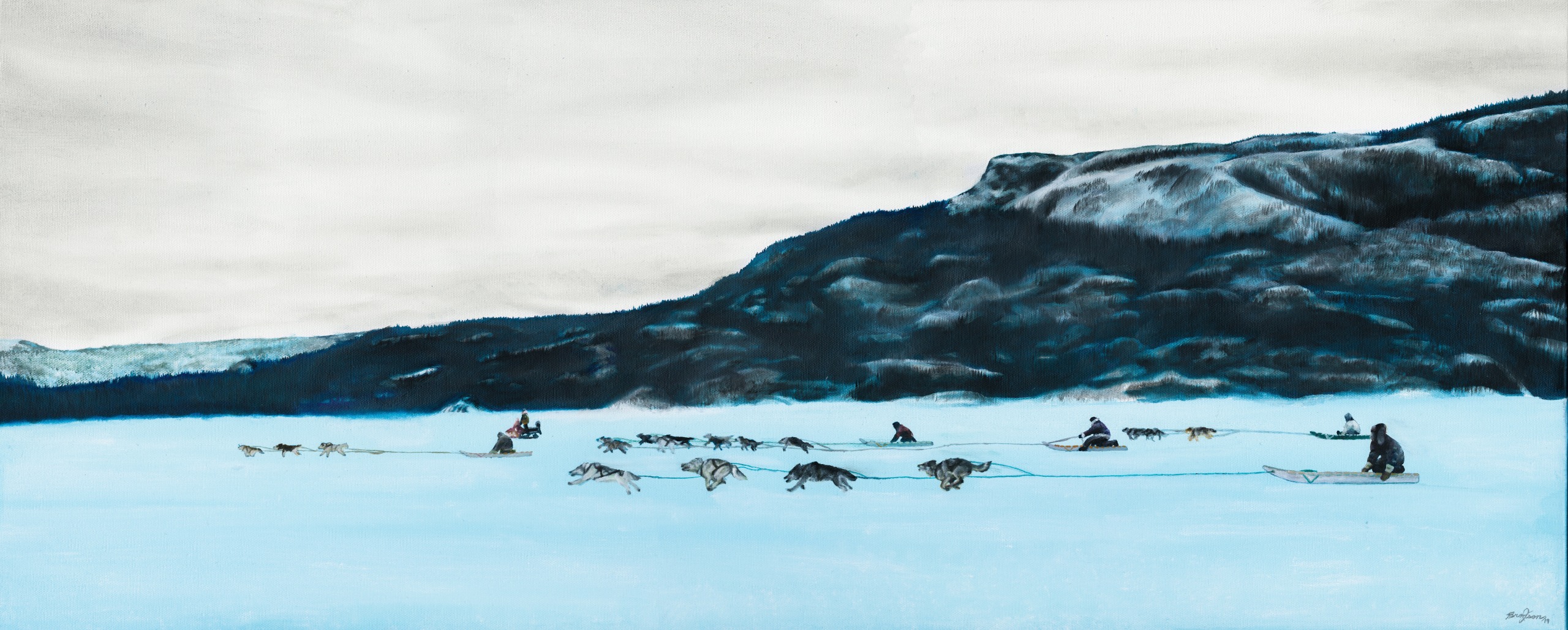 Image: Heritage Dog Team Race (2019), © Bronson Jacque
Image: Heritage Dog Team Race (2019), © Bronson Jacque
Q: How do you feel about the Indigenous Renaissance taking place across Canada?
Jacque: There’s definitely an Indigenous Renaissance taking place, and it’s not just in the art world. I’m also seeing it in communities. I see so many Indigenous people making efforts to reclaim their history. I’ve recently done a painting based on that called The Journey Home. It’s great to see so many young people who are really proud of who they are. The Indigenous Renaissance is so important because it strengthens our communities and helps reduce that feeling of not knowing where you belong, of displacement.
Q: What do you like about working for the Inuit Art Foundation?
Jacque: I work as a Contributing Editor for Inuit Art Foundation and do things like edit profiles, conduct interviews, transcribe interviews, among many other things. It’s been great because it’s given me the opportunity to talk to other Inuit artists and hear their stories and help them tell their stories.
With the support of RBC Foundation, Inuit Art Foundation has been able to scale the programming, mentorship and other profile and developmental opportunities to emerging Inuit artists to increase their visibility and expand their careers. Bronson’s journey illustrates the success that is possible and we’re delighted that IAF and our supporters can play a role in furthering their reach to new audiences worldwide. Alysa Procida, Executive Director at Inuit Art Foundation.
Q: What does it mean to you to be featured in the opening exhibit at Qaumajuq?
Jacque: Being featured is a huge honor. It’s my first time being featured in any sort of gallery setting. Having my work featured alongside countless talented artists is something that I cannot begin to express my gratitude for.
Q: What advice do you have for other young Indigenous artists?
Jacque: Don’t just do the things that you think are marketable. Don’t do things that you feel people want to see. Do the things that you feel are worth being shown. If you feel like something is worth putting time into — then it’s worth being put down on paper or carved into stone or put into song or poetry. If it’s a valuable thing to you, if it’s authentic and true — it’s going to be worth it.
As a champion of emerging artists, RBC supports programming at Inuit Art Foundation and is a longtime supporter of Winnipeg Art Gallery and its opening of Qaumajuq. Qaumajuq is the world's first art institution dedicated to Inuit art and culture and is set to open (virtually) in March 2021.
Download the PDF version
ᐳᕌᓐᓴᓐ ᔮᒃ: ᓄᓇᖃᖅᑳᖅᑐᒥᓂᖅ ᒪᑭᒋᐊᒃᑲᓂᖅᑐᒥᓂᖅ
ᑎᑎᕋᖅᑕᒥᓂᖅ ᐊᒫᓐᓇ ᕉᒥᒧᑦ
ᐅᓂᒃᑳᕈᒪᕖᑦ ᓇᒦᓐᓂᖏᓐᓂᓪᓗ, ᓴᓇᓐᖑᐊᖅᑎ ᐳᕌᓐᓴᓐ ᔮᒃ ᐅᓪᓗᒥᓕᓴᕐᓂᑦ ᐃᓄᐃᑦ ᐃᓅᓯᖏᓐᓂ ᓴᖅᑭᔮᖅᑎᑦᑎᔪᖅ.
ᑖᓐᓇ ᐃᓄᓱᑦᑐᖅ ᐃᓄᒃ ᓴᓇᓐᖑᐊᖅᑎ ᓯᕗᒃᑲᖅᑕᐃᔪᖅ ᓄᓇᖃᖅᑳᖅᑐᒥᓂᕐᓂᑦ ᒪᓂᒪᔾᔪᑎᔅᓴᐅᔪᓂᒃ ᐅᓂᒃᑳᖅᑐᐊᕐᓂᕐᒧᑦ ᓄᓇᓕᖏᓐᓂ ᐊᒥᐊᒐᖏᓐᓂᓪᓗ.
ᑕᑯᒃᑲᓐᓂᕈᒪᓐᓂᕈᕕᑦ ᔮᒃ ᓴᓇᐅᒐᖏᓐᓂ, ᖃᐅᔨᒋᐊᕈᓐᓇᖅᑐᑎᑦ ᖃᕋᓴᐅᔭᒃᑯᑦ ᐅᕗᖓ. https://www.bronsonjacqueart.com/.
ᐳᕌᓐᓴᓐᓂ ᔭᒃ, ᐃᓅᓱᑦᑐᖅ ᐃᓄᒃ ᐊᒥᐊᕆᔨ ᐴᔅᕕᐅᒥ, ᓄᓇᑦᓯᐊᕗᑦ, ᓅᐸᓪᓚᒥ ᓛᐸᑐᐊᒥᓗ, ᓯᕗᓪᓕᖅᐹᒥ ᐃᖅᑲᓇᐃᔭᖅᑖᕆᓂᐅᓴᔭᖓ: ᑕᑯᔅᓴᐅᑎᑕᐅᖃᑦᑕᖅᓯᒪᔪᑦ ᐊᒥᐊᒐᖏᑦ ᑕᑯᔭᒐᖃᕐᕕᒻᒥ ᐱᖅᑯᓯᖏᓐᓂᓪᓗ ᑕᑯᔅᓴᐅᑎᑦᑎᑎᓪᓗᒋᑦ ᐃᓄᐃᑦ ᑲᓇᑕᒥ ᐅᖓᑖᓄᓪᓗ.
ᖃᐅᒪᔪᖅ (ᐅᖃᖅᑕᐅᓲᖅ ᐃᒫᒃ KOW-ma-yourq ᐅᕝᕙᓘᓐᓃᑦ HOW-ma-yourk ) ᓯᕗᓪᓕᖅᐹᒥ ᓯᓚᕐᔪᐊᒥ ᑕᑯᔭᒐᖃᕐᕕᒻᒦᑎᑕᐅᓯᒪᓕᖅᑐᑦ ᐃᓄᓐᓄᑦ ᓴᓇᐅᒐᕐᓂᑦ ᐱᖅᑯᓯᖏᓐᓂᓪᓗ. ᐅᐃᓂᐹᒥ ᑕᑯᔭᒐᖃᕐᕕᖓᓐᓂ (WAG), ᖃᐅᔨᒪᔪᖅ ᓯᕗᓪᓕᖅᐹᒥ ᑕᑯᔅᓴᐅᑎᓐᓂᐊᖅᑕᖏᑦ INUA ᑲᑎᑎᑦᑎᔪᑦ ᐅᖓᑖᓄᑦ 90 ᐃᓄᓐᓂᑦ ᓴᓇᓐᖑᐊᖅᑎᓂᒃ ᑲᓇᑕᒦᓐᖔᖅᓯᒪᔪᓂᒃ.
ᒪᑐᐃᓛᖅᑐᖅ 2021−ᒥ, ᑕᑯᔭᒐᖃᕐᕕᒃ ᒪᑐᓲᑦ (ᐊᒥᐊᖅᑕᐅᓯᒪᔪᓂᒃ ᒪᑐᐃᖅᓯᔾᔪᑎᖃᖅᑑᔮᖅᑐᖅ) ᔭᓇᔭᐅᓯᒪᔪᑦ ᔮᒃᒧᑦ.
ᒫᓐᓇ ᐃᓕᓐᓂᐊᖅᑎ ᓅᕙ ᓯᑰᓴᒥ ᓯᓚᑦᑐᖅᓴᕐᕕᖓᓐᓂ ᓴᓇᓐᖑᐊᕐᓂᕐᒧᑦ ᓯᓚᑦᑐᖅᓴᕐᕕᔾᔪᐊᖓᓐᓂ ᐊᒻᒪᓗ ᑎᑎᕋᓲᖑᓪᓗᓂ ᐃᓄᐃᑦ ᓴᓇᐅᒐᖏᑕ ᒥᔅᓵᓄᑦ, ᔮᒃ ᐱᕈᖅᓴᓚᐅᖅᓯᒪᔪᖅ ᐃᓚᒌᖏᓐᓃᑦᑐᓂ ᓴᓇᓐᖑᐊᖅᑎᓂᓪᓗ. ᐃᓪᓗᓕᐅᖅᑎᐅᖃᑕᐅᑲᐃᓐᓇᓚᐅᖅᓯᒪᓪᓗᓂ, ᖁᕕᐊᒋᔭᒥᓂᒃ ᓇᓂᓯᓚᐅᖅᓯᒪᔪᖅ ᑕᑯᓪᓗᓂᓗ ᓴᓇᓐᖑᐊᕈᓐᓇᕐᓂᖓᓐᓂ.
 ᐊᔾᔨᓐᖑᐊᖅ: ᐊᖓᖓ/ᐊᒃᑲᖓ ᑕᒃ ᐅᐊᑉ (Doug’s Wharf) (2019), © ᐳᕌᓐᓴᓐ ᔮᒃ
ᐊᔾᔨᓐᖑᐊᖅ: ᐊᖓᖓ/ᐊᒃᑲᖓ ᑕᒃ ᐅᐊᑉ (Doug’s Wharf) (2019), © ᐳᕌᓐᓴᓐ ᔮᒃ
Q: ᖃᓄᖅ ᐃᓚᒌᑦᑎᒍᑦ ᐱᕈᖅᓴᓪᓗᑎᑦ ᓴᓇᓐᖑᐊᖅᑐᓂᒃ ᑕᑯᓐᓇᓐᖑᐊᓕᕐᓂᖅᑭᑦ ᓯᓚᕐᔪᐊᒥ?
ᔮᒃ: ᓴᓇᓐᖑᖃᖅᑎᓃᓐᖔᖅᓯᒪᓪᓗᓂ ᐃᓚᓐᓂᑦ, ᐊᔭᐅᖅᑐᖅᑕᐅᖏᓐᓇᓚᐅᖅᓯᒪᔪᖓ ᖃᓄᐃᑦᑐᑐᐃᓐᓇᕐᓂᑦ ᐱᓇᓱᖁᔭᐅᓪᓗᖓ. ᐊᑖᑕᒪ ᐅᖃᐅᑏᓐᓇᖅᐸᓚᐅᖅᓯᒪᒑᖓ ᐱᐅᓂᖅᐹᖑᒪᑦ ᐊᒡᒐᓐᓄᑦ ᓇᒻᒥᓂᖅ ᓴᓇᓪᓗᓂ ᐱᔭ ᕇᖅ ᑎᓪ ᓗᒍ . ᐃᓚᒃ ᑲ ᑕᑯ ᓐ ᓇᖅ ᓯ ᒪ ᔭ ᒃ ᑲ ᓴ ᓇᑎᓪ ᓗᒋ ᑦ ᓲ ᕐ ᓗ ᖁᓕᑦ ᑕᐅᔭ ᓕᐅᖅ ᑐᑎᑦ , ᐳᐊᓗᑦ ᓴ ᓇᓐ ᖑᐊᕐ ᓂᓪ ᓗ ᐱᒃ ᑯ ᒋ ᑦ ᑎᐊᖅ ᑐᒋ ᓪ ᓗ. ᓴ ᓇᓐ ᖑᐊᕐ ᓂᖅ ᓴ ᖅ ᑭ ᑎᑦ ᑎᒻ ᒪ ᑦ ᐱᖅ ᑯ ᓯ ᑦ ᑎᓐ ᓂ.
Q: ᖃᓄᖅ ᐅᖃᕋ ᓱ ᐅᖅ ᑭ ᑦ ᐅᕝ ᕙᓘᓐ ᓃᑦ ᓴ ᓇᓱ ᑦ ᑕᑎᑦ ᓴ ᓇᓐ ᖑᐊᖅ ᑕᑎᑦ ?
ᔮ ᒃ : ᑐᕌ ᒐ ᕋ ᓕ ᐅᓂᒃ ᑳ ᖅ ᑐᐊᕐ ᒥ ᑦ ᓴ ᖅ ᑭ ᑎᑦ ᑎᓗᖓ ᓇᑭ ᓐ ᖔᖅ ᓯ ᒪ ᓂᖏᓐ ᓂ ᓄᓇᒋ ᓚᐅᖅ ᓯ ᒪ ᔭ ᕐ ᓂᑦ . ᑕᑯ ᔅ ᓴ ᐅᑎᑦ ᑎᒍ ᒪ ᒐ ᒪ ᑭ ᓱ ᑐᐃᓐ ᓇᕐ ᓂᑦ ᐅᕙᓐ ᓃᓐ ᖔᖅ ᓯ ᒪ ᔪ ᓂᒃ ᑕᑯ ᔅ ᓴ ᐅᑎᑦ ᑎᓗᖓ ᖃᓄᐃᑦ ᑑᓂᖏᓐ ᓂ. ᐅᓂᒃ ᑳ ᖅ ᑐᐊᕐ ᓂ ᓴ ᖅ ᑮ ᔪ ᒪ ᒐ ᒪ ᓴ ᓇᓐ ᖑᐊᒐ ᖅ ᑎᒍ ᑦ ᐃᓅᓯ ᑦ ᑎᓐ ᓃᓐ ᖔᖅ ᑐᓂᑦ .
Q: ᑭ ᓱ ᒥ ᑦ ᐱᒃ ᑯ ᒋ ᔭ ᖃᖅ ᑐᑎᑦ ᓴ ᓇᖃᑦ ᑕᕈ ᒪ ᓕᓚᐅᖅ ᑭ ᑦ ᓲ ᕐ ᓗ ᐃᓪ ᓗᓕᐅᕐ ᓂᕐ ᒥ ᑦ , ᐊᕕ ᕋ ᔭ ᕐ ᓂᑦ ᑲ ᒪ ᓂᕐ ᒥ ᑦ , ᖃᐅᔨ ᓴ ᕐ ᓂᕐ ᒥ ᑦ ?
ᔮ ᒃ : ᐃᓪ ᓗᓕᐅᖅ ᑎᐅᑲ ᐃᓐ ᓇᓚᐅᖅ ᓯ ᒪ ᒐ ᒪ ᐅᑭ ᐅᓄᑦ ᑎᓴ ᒪ ᓄᑦ ᓴ ᓇᔨ ᑐᐃᓐ ᓇᐅᓪ ᓗᖓ ᐊᒻ ᒪ ᓗ ᐊᓯ ᖏᓐ ᓂ ᑭ ᒃ ᑯ ᕈ ᓘᔮ ᓗᓐ ᓂ ᑲ ᑎᓯ ᖃᑦ ᑕᖅ ᑐᖓ ᓇᑭ ᑐᐃᓐ ᓇᖅ ᑐᓂᑦ − ᑕᐃᑲ ᓂ ᐱᒋ ᐊᓕᓚᐅᖅ ᓯ ᒪ ᔪ ᖓ. ᐃᓄᑑᓪ ᓗᖓ ᐱᓗᐊᖅ ᑐᒥ ᑦ , ᖃᐅᔨ ᕙᓪ ᓕᐊᓪ ᓗᒋ ᑦ , ᐅᓂᒃ ᑳ ᕐ ᓂᓪ ᓗ ᓴ ᖅ ᑮ ᒍ ᒪ ᓕᖅ ᑐᖓ.
ᑕᐃᑲ ᓂ ᐅᑭ ᐅᓂᑦ ᑎᓴ ᒪ ᓂᒃ , ᓇᒻ ᒥ ᓂᖅ ᐃᓱ ᒪ ᒋ ᒃ ᑲ ᓐ ᓂᓕᓚᐅᖅ ᓯ ᒪ ᒐ ᒪ . ᑮ ᓇᐅᔭ ᓕᐅᖅ ᑎᐊᖅ ᑐᖓᓪ ᓗ, ᑭ ᓯ ᐊᓂᓕ ᖁᕕ ᐊᓱ ᓗᐊᕐ ᓇᖓ. ᐅᔾ ᔨ ᕈ ᓱ ᑉ ᐹᓪ ᓕᓕᖅ ᑐᖓᓪ ᓗ ᓲ ᕐ ᓗ ᐱᓇᓱ ᒋ ᐊᓕᓐ ᓂ ᐱᓇᓱ ᓐ ᓇᖓ. ᐊᑕᐅᓯ ᒃ ᑲ ᓂᕐ ᒥ ᑦ ᐱᖃᕐ ᒥ ᔪ ᖓ ᑕᐃᑲ ᓂ ᑕᑯ ᔅ ᓴ ᐅᑎᑕᐅᔪ ᒥ ᑦ INUA ᑕᐃᒪ ᐃᑦ ᑐᓂᑦ ᐃᑉ ᐱᒋ ᓯ ᒪ ᔭ ᕐ ᓂᑦ ᑕᑯ ᔅ ᓴ ᐅᑎᑦ ᑎᔪ ᒥ ᑦ . ᑕᑯ ᔅ ᓴ ᐅᔪ ᖅ ᐊᒥ ᐊᖅ ᓯ ᒪ ᔭ ᕋ ᐊᔅ ᓱ ᕈ ᓐ ᓇᖅ ᑐᒃ ᑰ ᖅ ᓯ ᒪ ᑎᓪ ᓗᑕ ᓄᓇᓕᑦ ᑎᓐ ᓂ ᐱᔪ ᒪ ᓐ ᖏᑕᑦ ᑎᓐ ᓂ ᐱᑎᑕᐅᓇᓯ ᑦ ᑎᓪ ᓗᑕ ᐊᕙᑎᑦ ᑎᓂᓪ ᓗ.
ᐃᓪ ᓗᓕᐅᖅ ᑎᐅᖃᑕᐅᑎᓪ ᓗᖓ, ᐊᒥ ᓱ ᓂᑦ ᓄᓇᓕᑦ ᑎᓐ ᓂ ᓴ ᓇᔪ ᖃᖅ ᐸᔪ ᒻ ᒪ ᑦ ᓄᓇᑦ ᑎᓐ ᓂ ᓴ ᐳᒻ ᒥ ᑦ ᑎᔪ ᓂᒃ . ᓄᓇ ᐱᔭ ᐅᓚᐅᖅ ᓯ ᒪ ᒻ ᒪ ᑦ 100−ᖏᓐ ᓃᑦ ᑐᓂᑦ ᐅᑭ ᐅᓂᑦ ᐊᓂᒍ ᖅ ᓯ ᒪ ᓕᖅ ᑐᓂᑦ . ᐃᓛᑎᒍ ᑦ ᐃᖅ ᑲ ᓇᐃᔭ ᖅ ᑎᑕᐅᓪ ᓗᑕ ᓄᓇᑦ ᑎᓐ ᓂ ᐅᑭ ᐅᒐ ᓴ ᕐ ᓄᑦ . ᑕᐃᒫ ᒃ ᐊᑲ ᐅᑦ ᑎᐊᕐ ᓇᖏᓪ ᓚᕆᖅ ᑐᖅ ᓱ ᕋ ᐃᔭ ᐃᓗᓂ ᐃᓅᓯ ᕆᓗᒍ ᓗ. ᑭ ᓯ ᐊᓂᓕ ᐊᓯ ᖏᓐ ᓂ ᑮ ᓇᐅᔭ ᓕᐅᕈ ᑎᑕᖃᕐ ᒥ ᔫ ᒐ ᓗᐊᖅ . ᓴ ᓐ ᖏᓂᖃᕐ ᓇᖏᑦ ᑐᖅ ᐃᑉ ᐱᓐ ᓂᐊᓇᖅ ᑐᖅ ᑕᐃᒫ ᒃ ᐊᒻ ᒪ ᓗ ᑕᒪ ᒃ ᑯ ᐊ ᐃᓱ ᒪ ᒋ ᓪ ᓗᒋ ᑦ ᐊᒥ ᐊᕆᓇᓱ ᖃᑦ ᑕᖅ ᑐᖓ.
 ᐊᔾ ᔨ ᓐ ᖑᐊᖅ : ᕿᒧ ᔅ ᓰ ᑦ ᓱ ᒃ ᑲ ᓕᓂᑭ ᓴ ᐅᑎᔪ ᑦ (2019), © ᐳᕌ ᓐ ᓴ ᓐ ᔮ ᒃ
ᐊᔾ ᔨ ᓐ ᖑᐊᖅ : ᕿᒧ ᔅ ᓰ ᑦ ᓱ ᒃ ᑲ ᓕᓂᑭ ᓴ ᐅᑎᔪ ᑦ (2019), © ᐳᕌ ᓐ ᓴ ᓐ ᔮ ᒃ
Q: ᖃᓄᖅ ᐃᑉ ᐱᒍ ᓱ ᑉ ᐱᑦ ᓄᓇᖃᖅ ᑳ ᖅ ᑐᒥ ᓃᑦ ᓴ ᖅ ᑭ ᑲ ᓐ ᓂᑎᓪ ᓗᒋ ᑦ ᑲ ᓇᑕᒥ ?
ᔮ ᒃ : ᓄᓇᖃᖅ ᑳ ᖅ ᑐᒥ ᓂᕐ ᓂᑦ ᓴ ᖅ ᑭ ᑲ ᓐ ᓂᖅ ᑐᖃᓪ ᓚᕆᑦ ᑐᖅ , ᓴ ᓇᓐ ᖑᐊᕐ ᓂᑑᒥ ᐅᓐ ᖏᑦ ᑐᖅ . ᓄᓇᓕᓐ ᓂᑦ ᑕᑯ ᔪ ᖓ. ᐊᒥ ᓱ ᓂᓪ ᓗ ᓄᓇᖃᖅ ᑳ ᖅ ᑐᒥ ᓂᕐ ᓂᑦ ᐊᔅ ᓱ ᕈ ᖅ ᑐᓂᑦ ᑎᒍ ᓯ ᒃ ᑲ ᓐ ᓂᕋ ᓱ ᐊᖅ ᑐᓂᑦ ᐱᖅ ᑯ ᑎᒋ ᓚᐅᖅ ᓯ ᒪ ᔭ ᖏᓐ ᓂ ᐅᐊᑦ ᑎᐊᕈ ᐱᓇᓱ ᐊᖅ ᑐᓂᒃ . ᐊᒥ ᐊᕆᕋ ᑖᓚᐅᕐ ᒥ ᒐ ᒪ ᐊᑎᓕᒃ ᐊᖏᕐ ᕋ ᑎᓐ ᓄᑦ ᐊᖅ ᑯ ᑎᕗᑦ . ᑕᑯ ᒋ ᐊᖓ ᐃᓅᓱ ᑦ ᑐᓂᑦ ᐊᒥ ᓱ ᓂᑦ ᐅᐱᓐ ᓇᑦ ᑎᐊᖅ ᑐᖅ ᑭ ᒃ ᑰ ᓂᖏᓐ ᓂ ᓴ ᖅ ᑭ ᔮ ᖅ ᑎᑦ ᑎᔪ ᓂᒃ . ᓄᓇᖃᖅ ᑳ ᖅ ᑐᒥ ᓂᕐ ᓂᑦ ᐅᑎᖅ ᐸᓪ ᓕᐊᔪ ᓂᒃ ᐱᒻ ᒪ ᕆᐊᓘᒻ ᒪ ᑦ ᓴ ᓐ ᖏᓂᐅᒻ ᒪ ᑦ ᓄᓇᓕᓐ ᓂ ᐃᑲ ᔫ ᑎᖃᖅ ᑐᑎᓪ ᓗ ᓇᑭ ᓐ ᖔᖅ ᓯ ᒪ ᓂᖏᓐ ᓂ ᐃᓕᓴ ᖅ ᓯ ᓯ ᒪ ᓂᖅ ᓴ ᐅᓕᖅ ᑐᑎᑦ , ᑕᒫ ᓃᖅ ᑭ ᔫ ᔮ ᓐ ᖏᓂᖅ ᓴ ᐅᓕᖅ ᑐᑎᑦ .
Q: ᖃᓄᐃᑦ ᑐᓂᑦ ᐱᐅᒋ ᔭ ᖃᖅ ᑭ ᑦ ᐃᓄᐃᑦ ᓴ ᓇᓐ ᖑᐊᒐ ᖏᓐ ᓂ ᑐᓐ ᖓᕕ ᐅᔪ ᓂᒃ ?
ᔮ ᒃ : ᐃᓚᒋ ᔭ ᐅᖃᑕᐅᓪ ᓗᖓ ᑎᑎᕋ ᖃᑕᐅᕙᑦ ᑐᖓ ᐃᓄᐃᑦ ᓴ ᓇᓐ ᖑᐊᕐ ᓂᖏᓐ ᓂ ᑐᓐ ᖓᕕᖓᓐ ᓂ ᐅᓂᒃ ᑳ ᕐ ᓂᑦ ᐊᖅ ᑭ ᔅ ᓱ ᐃᖃᑦ ᑕᖅ ᑐᖓ, ᐊᐱᖅ ᓱ ᖃᑦ ᑕᖅ ᑐᖓ, ᐊᐱᖅ ᓲ ᑎᒥ ᓂᕐ ᓂᑦ ᓇᕿᑦ ᑕᖅ ᑐᖓ, ᐊᓯ ᖏᓐ ᓂᓪ ᓗ. ᖁᕕ ᐊᓇᓪ ᓚᕆᑦ ᑐᖅ ᐅᐱᓐ ᓇᕋ ᓂ ᐅᓂᒃ ᑳ ᕈ ᓐ ᓇᖅ ᑎᑕᐅᒐ ᒪ ᐊᓪ ᓚᐃᑦ ᓴ ᓇᓐ ᖑᐊᒐ ᖏᓐ ᓂ ᐊᒻ ᒪ ᓗ ᑐᓴ ᖅ ᑕᐅᓪ ᓗᑎᑦ ᐅᓂᒃ ᑳ ᖅ ᑐᐊᑦ ᐃᑲ ᔪ ᖅ ᑐᒋ ᓪ ᓗ ᐅᓂᒃ ᑳ ᖅ ᑐᐊᖏᓐ ᓂ ᓴ ᖅ ᑮ ᓇᓱ ᑦ ᑎᓪ ᓗᒋ ᑦ .
“ᐃᑲᔪᖅᑐᖅᑕᐅᓪᓗᓂ RBC ᑎᒥᖓᓐᓄᑦ, ᐃᓄᐃᑦ ᓴᓇᓐᖑᐊᖅᑏᑦ ᑐᓐᖓᕕᖓ ᐃᑲᔫᑎᔅᓴᖃᕐᒥᒻᒪᑕ, ᐃᓕᓐᓂᐊᑎᑦᑎᒍᓐᓇᖅᑐᑎᑦ ᐃᓛᒃᑯᑦ ᐊᒻᒪᓗ ᐊᓯᖏᓐᓂ ᑕᑯᔅᓴᐅᑎᑦᑎᓗᑎᑦ ᐋᖅᑭᔅᓱᐃᒍᓐᓇᕐᓗᑎᓪᓗ ᐃᓄᐃᑦ ᓴᓇᓐᖑᐊᒐᖏᓐᓂ ᐊᒥᓱᕈᖅᑎᑦᑎᑲᓐᓂᕋᓱᐊᕐᓗᑎᑦ ᑕᑯᔅᓴᐅᔪᓐᓇᖅᑐᓂᒃ ᑕᐃᒫᓪᓗ ᐃᖅᑲᓇᐃᔮᕆᓗᒋᑦ. ᐳᕌᓐᓴᓐ ᐊᖅᑯᑎᒋᓯᒪᔭᖓ ᑲᔪᓯᑦᑎᐊᖅᓯᒪᔪᐊᓘᒻᒪᑦ ᖁᕕᐊᑦᑎᐊᖅᑐᒍᑦ IAF−ᑯᑦ ᐊᒻᒪᓗ ᐃᑲᔪᖅᑎᕗᑦ ᐃᓚᒋᔭᐅᔪᓐᓇᕐᖓᑕ ᑕᒪᑐᒥᖓ ᑲᔪᓯᑎᑦᑎᓇᓱᐊᖅᑎᓪᓗᒍ ᑕᑯᔭᐅᔪᓐᓇᖅᑐᓄᑦ ᓯᓚᕐᔪᐊᓕᒫᒧᑦ.” ᐊᓖᓴ ᐳᕆᑕ, ᐃᖅᑲᓇᐃᔭᖅᑎᓄᑦ ᓯᕗᓕᖅᑎ ᐃᓄᐃᑦ ᓴᓇᓐᖑᐊᖅᑎᖏᑦᑕ ᑐᓐᖓᕕᖓᓐᓂ
Q: ᖃᓄᖅ ᐃᑉ ᐱᒋ ᑎᒋ ᕕ ᐅᒃ ᒪ ᑐᐃᖅ ᓯ ᔪ ᖃᕐ ᓂᐊᖅ ᑎᓗᒍ ᑕᑯ ᔅ ᓴ ᐅᑎᑕᐅᓂᐊᕐ ᓂᖏᓐ ᓂ ᖃᐅᒪ ᔪ ᖅ ?
ᔮ ᒃ : ᑕᑯ ᔅ ᓴ ᐅᑎᑕᐅᓂᐊᖅ ᑎᓪ ᓗᒍ ᐊᖏᔪ ᐊᓗᒃ ᐅᕙᓐ ᓄᑦ . ᓯ ᕗᓪ ᓕᖅ ᐹᒥ ᑕᑯ ᔅ ᓴ ᐅᑎᑕᐅᓂᐊᕐ ᖓᑕ ᓴ ᓈᒃ ᑲ ᑕᑯ ᔭ ᒐ ᖃᕐ ᕕ ᒻ ᒥ . ᓴ ᓇᐅᒐ ᒃ ᑯ ᑦ ᑕᑯ ᔅ ᓴ ᐅᑎᑕᐅᑎᓪ ᓗᒋ ᑦ ᐊᒥ ᓱ ᐊᓗᐃᓪ ᓗ ᓴ ᓇᓐ ᖑᐊᖅ ᑏᑦ ᖁᔭ ᓕᓂᐊᓗᒐ ᒥ ᑭ ᓗᐊᖅ ᑑᔮ ᒻ ᒪ ᕆᑦ ᑐᖅ .
Q: ᖃᓄᖅ ᓄᓇᖃᖅ ᑳ ᖅ ᑐᒥ ᓂᕐ ᓂᑦ ᓴ ᓇᓐ ᖑᐊᖅ ᑎᓄᑦ ᐅᖃᕈ ᒪ ᒐ ᔭ ᖅ ᑭ ᑦ ?
ᔮ ᒃ : ᐱᐅᔪ ᑐᐊᕌ ᓘᔭ ᖅ ᑐᓂᑦ ᑲ ᒪ ᑐᐃᓐ ᓇᖏᓪ ᓗᑎᑦ . ᐃᑉ ᐱᒋ ᔭ ᐅᖁᔭ ᐅᔪ ᓂᒃ ᑲ ᒪ ᑐᐃᓐ ᓇᖏᓪ ᓗᑎᑦ . ᐃᑉ ᐱᒋ ᔭ ᕐ ᓂᑦ ᐱᐅᒋ ᔭ ᕐ ᓂᑦ ᑕᑯ ᔅ ᓴ ᐅᑎᑦ ᑎᖔᕐ ᓗᑎᑦ . ᐱᐅᔪ ᒥ ᑦ ᑕᑯ ᓐ ᓇᓐ ᖑᐊᕈ ᑎᑦ ᑲ ᒪ ᒋ ᖔᕐ ᓗᒍ − ᐸᐃᑉ ᐹᒨ ᖅ ᐸᓪ ᓕᐊᓗᒍ ᓴ ᓇᓐ ᖑᐊᓕᕐ ᓗᒍ ᐅᕝ ᕙᓘᓐ ᓃᑦ ᐃᓐ ᖏᐅᓯ ᕐ ᒧ ᑦ ᐅᖃᓕᒫ ᒐ ᕐ ᒧ ᓪ ᓗᓐ ᓂᑦ . ᐃᓕᓐ ᓄᑦ ᐊᑐᐃᓐ ᓇᐅᑉ ᐸᑕ, ᐱᐅᒋ ᒍ ᕕ ᐅᒃ ᓱ ᓕᑦ ᑎᐊᕐ ᓗᓂᓗ − ᐱᐅᓯ ᓪ ᓚᕆᓐ ᓂᐊᖅ ᑐᖅ .
ᓵ ᓚᓕᒃ ᓴᓇᓐᖑᐊᖅᑎᕈᖅᐸᓪᓕᐊᔪᒥᑦ, RBC ᐃᑲ ᔪ ᖅ ᑐᐃᔪ ᑦ ᑕᐃᒪ ᐃᑦ ᑐᓂᑦ ᐃᓄᐃᑦ ᓴᓇᓐᖑᐊᒐᖏᓐᓂ ᑐᓐᖓᕕᐅᔪᖅ ᐊᒻ ᒪ ᓗ ᐊᑯ ᓂᐊᓗᒃ ᐃᑲ ᔪ ᖅ ᑐᐃᓪ ᓗᑎᑦ ᐅᐃᓂᐹᒻ ᒥ ᓴ ᓇᓐ ᖑᐊᒐ ᕐ ᓂᑦ ᑕᑯ ᔭ ᒐ ᖃᕐ ᕕ ᒃ ᒪ ᑐᐃᖅ ᓯ ᓛᖅ ᑐᑦ ᖃᐅᒪ ᔪ ᕐ ᒥ ᑦ . ᖃᐅᒪᔪᖅ ᓯ ᓚᕐ ᔪ ᐊᒥ ᓯ ᕗᓪ ᓕᖅ ᐹᑦ ᑎᐊᖅ ᑭ ᒡ ᒐ ᖅ ᑐᐃᔪ ᖅ ᐃᓄᐃᑦ ᓴ ᓇᐅᒐ ᖏᓐ ᓂ ᐱᖅ ᑯ ᓯ ᖏᓐ ᓂᓪ ᓗ ᒪ ᑐᐃᓛᖅ ᑐᓂᓗ (ᑕᑯ ᔅ ᓴ ᐅᓗᓂ) ᒫ ᔾ ᔨ ᒥ 2021−ᒥ
This article is intended as general information only and is not to be relied upon as constituting legal, financial or other professional advice. A professional advisor should be consulted regarding your specific situation. Information presented is believed to be factual and up-to-date but we do not guarantee its accuracy and it should not be regarded as a complete analysis of the subjects discussed. All expressions of opinion reflect the judgment of the authors as of the date of publication and are subject to change. No endorsement of any third parties or their advice, opinions, information, products or services is expressly given or implied by Royal Bank of Canada or any of its affiliates.








